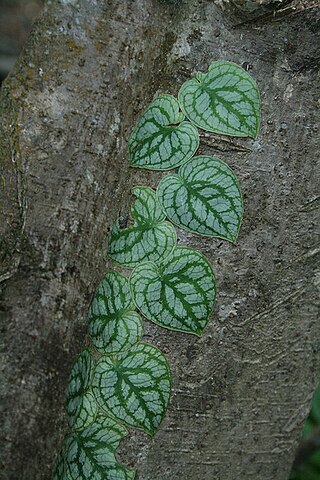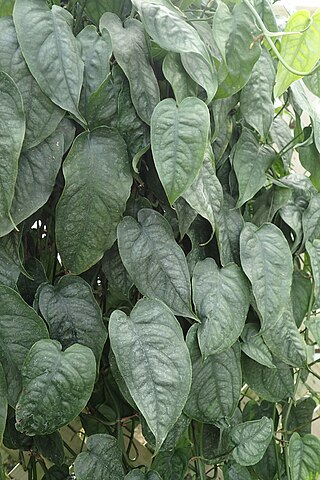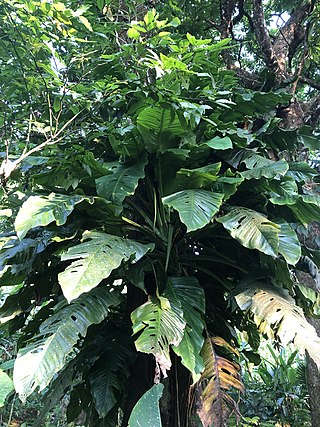
The Araceae are a family of monocotyledonous flowering plants in which flowers are borne on a type of inflorescence called a spadix. The spadix is usually accompanied by, and sometimes partially enclosed in, a spathe. Also known as the arum family, members are often colloquially known as aroids. This family of 114 genera and about 3,750 known species is most diverse in the New World tropics, although also distributed in the Old World tropics and northern temperate regions.

Monstera deliciosa, the Swiss cheese plant or split-leaf philodendron is a species of flowering plant native to tropical forests of southern Mexico, south to Panama. It has been introduced to many tropical areas, and has become a mildly invasive species in Hawaii, Seychelles, Ascension Island and the Society Islands. It is very widely grown in temperate zones as a houseplant.
Swiss cheese plant may refer to:

Monstera is a genus of 59 species of flowering plants in the arum family, Araceae, native to tropical regions of central and south America.

Monstera adansonii, the Adanson's monstera, Swiss cheese plant, or five holes plant, is a species of flowering plant from family Araceae, which is widespread across much of South America and Central America. Monstera adansonii is classified as a hemiepiphyte vine and can be found in tropical forests with hot and high humidity conditions. Other regions this plant may be found in are the West Indies, Antigua, Grenada, Saba, St. Kitts, Guadeloupe, Marie Galante, Dominica, Martinique, St. Lucia, St. Vincent, Tobago, and Trinidad. Currently, there are four recognized subspecies of Monstera adansonii subsp. adansonii, M. adansonii subsp. blanchetii,M. adansonii subsp. klotzschiana and Monstera adansonii subsp. laniata The species are quite common near river valleys at lower elevations.

Monstera acuminata, or shingle plant, is a species of flowering plant from family Araceae which is widespread from Mexico to Central America. It is abundant in central Petén and extends north to San Luis Potosí, making it the northernmost of the species of Monstera.

Monstera dubia is a species of plant in the genus Monstera native to Central and South America. M. dubia is known for the dramatic transformation its foliage makes as it climbs from seed stage on the forest floor, to shingling closely up a host tree trunk or other surface, until mature leaves with fenestrations similar to Monstera deliciosa appear. This transformation is an example of leaf dimorphism. Dubia refers to dubious, because authors were not certain that the species fell within the genus Marcgravia, where it was initially placed.

Monstera obliqua is a species of the genus Monstera native to Central and South America. It is hemiepiphytic like most other Monstera species. The plant is particularly known for its foliage, which is, in mature specimens of a few varieties, highly perforated, sometimes described as having more empty space than leaf. An illustration of the general variation in adult leaf shape from different individuals of this species can be found in Michael Madison's A Revision of Monstera. The species is not commonly cultivated, but the name is often misapplied to specimens of the more widespread Monstera adansonii.
Monstera tacanaensis is a species of flowering plant in the genus Monstera of the arum family, Araceae.

Monstera siltepecana is a species of flowering plant in the genus Monstera native to the wet tropical biomes of southern Mexico and Central America. Like other Monstera species, it is a vining plant and as it matures, develops holes in its leaves. Especially in immature foliage, it has distinctive silver venation. The monstera siltepecana is a very fast growing plant along with the other arum family members.

Monstera anomala is a flowering plant of genus Monstera and family Araceae.
Monstera barrieri is a flowering plant of the genus Monstera and family Araceae.
Monstera cenepensis is a species of flowering plants in the family Araceae.

Monstera egregia is a flowering plant belonging to genus Monstera of family Araceae.
Monstera guzmanjacobiae is a species of plant in the family Araceae from Mexico.
Monstera kessleri is a flowering plant in genus Monstera of the arum family Araceae.

Monstera lechleriana is a flowering plant in the genus Monstera in the arum family, Araceae. It is native to Bolivia, Colombia, Ecuador, Panamá, Peru, and Venezuela. The species is named for the German botanist Willibald Lechler, who collected the original type specimen in 1854. It was the scientifically described by Heinrich Wilhelm Schott by 1860. Like other species of Monstera, the plant is an epiphytic climbing vine which grows on the lower trunks of trees, and which produces large leaves with perforations when mature that appear on each side of the midrib of the foliage.
Monstera luteynii is a species of flowering plant in the genus Monstera of the arum family, Araceae.
Monstera molinae is a species of flowering plant in the genus Monstera in the arum family, Araceae.
Monstera subpinnata is a species of flowering plant native to Bolivia, Peru, Ecuador and Colombia. It grows as an epiphyte. The plant is best known for its pinnate leaves, which are unusual within the genus Monstera. The species can grow as tall as 12 m, with leaves growing as large as 40 cm long and 30 cm wide.










